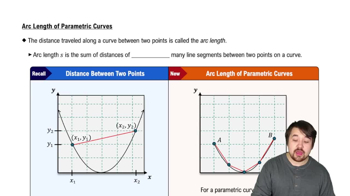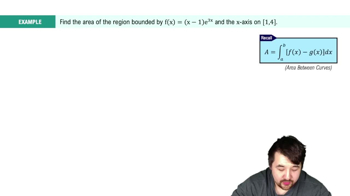Express the area of the shaded region in Exercise 5 as the sum of two integrals with respect to y. Do not evaluate the integrals.
Table of contents
- 0. Functions7h 54m
- Introduction to Functions16m
- Piecewise Functions10m
- Properties of Functions9m
- Common Functions1h 8m
- Transformations5m
- Combining Functions27m
- Exponent rules32m
- Exponential Functions28m
- Logarithmic Functions24m
- Properties of Logarithms36m
- Exponential & Logarithmic Equations35m
- Introduction to Trigonometric Functions38m
- Graphs of Trigonometric Functions44m
- Trigonometric Identities47m
- Inverse Trigonometric Functions48m
- 1. Limits and Continuity2h 2m
- 2. Intro to Derivatives1h 33m
- 3. Techniques of Differentiation3h 18m
- 4. Applications of Derivatives2h 38m
- 5. Graphical Applications of Derivatives6h 2m
- 6. Derivatives of Inverse, Exponential, & Logarithmic Functions2h 37m
- 7. Antiderivatives & Indefinite Integrals1h 26m
- 8. Definite Integrals4h 44m
- 9. Graphical Applications of Integrals2h 27m
- 10. Physics Applications of Integrals 3h 16m
- 11. Integrals of Inverse, Exponential, & Logarithmic Functions2h 34m
- 12. Techniques of Integration7h 41m
- 13. Intro to Differential Equations2h 55m
- 14. Sequences & Series5h 36m
- 15. Power Series2h 19m
- 16. Parametric Equations & Polar Coordinates7h 58m
9. Graphical Applications of Integrals
Area Between Curves
Problem 6.5.24a
Textbook Question
21–30. {Use of Tech} Arc length by calculator
a. Write and simplify the integral that gives the arc length of the following curves on the given interval.
y = x³/3, for −1≤x≤1
 Verified step by step guidance
Verified step by step guidance1
Recall the formula for the arc length of a curve defined by a function \( y = f(x) \) on the interval \( [a, b] \):
\[ L = \int_a^b \sqrt{1 + \left(\frac{dy}{dx}\right)^2} \, dx \]
Identify the function and the interval: here, \( y = \frac{x^3}{3} \) and \( x \) ranges from \( -1 \) to \( 1 \).
Compute the derivative \( \frac{dy}{dx} \) of the function:
\[ \frac{dy}{dx} = \frac{d}{dx} \left( \frac{x^3}{3} \right) = x^2 \]
Substitute \( \frac{dy}{dx} = x^2 \) into the arc length formula to get the integral:
\[ L = \int_{-1}^1 \sqrt{1 + (x^2)^2} \, dx = \int_{-1}^1 \sqrt{1 + x^4} \, dx \]
This integral expression represents the arc length of the curve on the given interval. It can be evaluated using a calculator or numerical methods since it does not have a simple antiderivative.
 Verified video answer for a similar problem:
Verified video answer for a similar problem:This video solution was recommended by our tutors as helpful for the problem above
Video duration:
1mPlay a video:
Was this helpful?
Key Concepts
Here are the essential concepts you must grasp in order to answer the question correctly.
Arc Length Formula
The arc length of a curve y = f(x) from x = a to x = b is given by the integral ∫ from a to b of √(1 + (dy/dx)²) dx. This formula calculates the length of the curve by summing infinitesimal line segments along the curve.
Recommended video:

Arc Length of Parametric Curves
Derivative of the Function
To apply the arc length formula, you need the derivative dy/dx of the function y = x³/3. Differentiating gives dy/dx = x², which is then squared inside the integral to find the integrand √(1 + (dy/dx)²).
Recommended video:

Derivatives of Other Trig Functions
Setting up and Simplifying the Integral
After finding dy/dx, substitute it into the arc length integral and simplify the expression under the square root. For y = x³/3, the integral becomes ∫ from -1 to 1 of √(1 + x⁴) dx, which may require numerical methods or a calculator for evaluation.
Recommended video:

Integration by Parts for Definite Integrals Example 7

 5:23m
5:23mWatch next
Master Finding Area Between Curves on a Given Interval with a bite sized video explanation from Patrick
Start learningRelated Videos
Related Practice
Textbook Question
9
views
